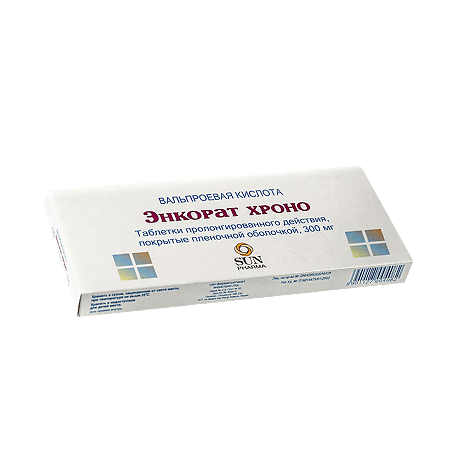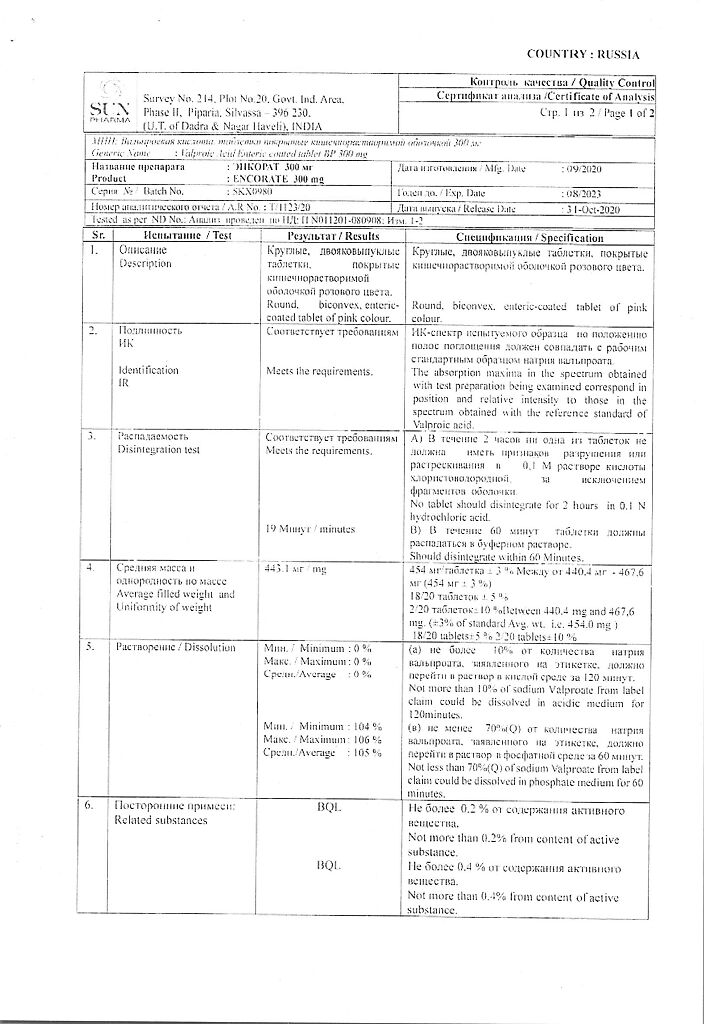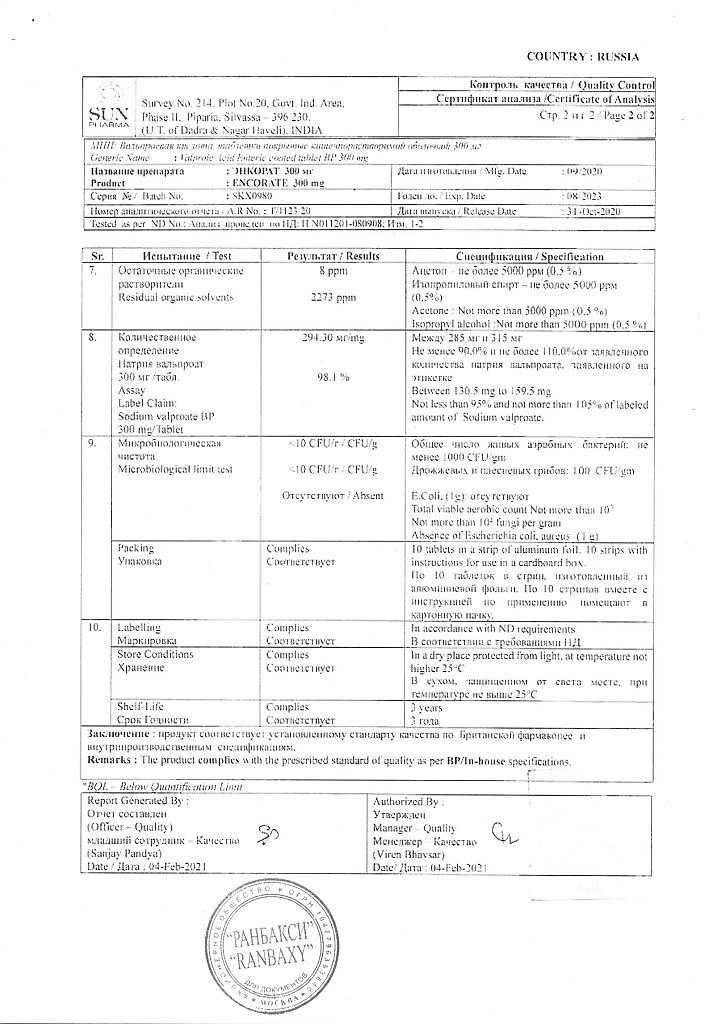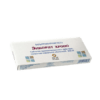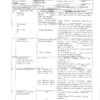No products in the cart.
Encorate, 300 mg 100 pcs
€1.00
Out of stock
(E-mail when Stock is available)
Description
The active substance Enkorat is able to have a central myorelaxant and sedative effect.
This is associated with reduction of seizure readiness and excitability of motor zones located in the brain.
In addition, regular intake of Encorate helps to improve the mood and mental state of patients.
Indications
Indications
– epilepsy – petit mal seizures (absences, complex absences);
– grand mal seizures;
– focal seizures.
Pharmacological effect
Pharmacological effect
The active ingredient Encorat can have a central muscle relaxant and sedative effect.
This is due to a decrease in convulsive readiness and excitability of motor areas located in the brain.
In addition, regular use of Encorat helps improve the mood and mental state of patients.
Special instructions
Special instructions
Before starting treatment and during treatment, it is recommended to monitor the functional state of the liver and pancreas, peripheral blood picture, and blood coagulation parameters. If disorders of the liver and pancreas, as well as blood clotting disorders occur or are suspected, the drug should be discontinued.
When combined therapy with other anticonvulsants and drugs, it is advisable to monitor, especially at the beginning of treatment, the plasma concentration of the other drug, since it may change under the influence of Encorat.
In patients receiving other antiepileptic drugs, the transition to valproic acid should be carried out gradually, reaching a clinically effective dose after 2 weeks, after which gradual withdrawal of other antiepileptic drugs is possible. In patients not treated with other antiepileptic drugs, a clinically effective dose should be achieved after 1 week.
The risk of side effects from the liver is increased during combination anticonvulsant therapy, as well as in children.
The increased risk of bleeding should be taken into account in patients receiving anticoagulant or thrombolytic therapy.
During treatment with Encorat, a false-positive urine reaction to ketone bodies is possible.
There are reports of changes in the functional state of the thyroid gland during therapy with Encorat.
Before surgery, a general blood test (including platelet count), determination of bleeding time, and coagulogram parameters are required.
If symptoms of an acute abdomen occur during treatment, before surgery, it is recommended to determine the level of amylase in the blood to exclude acute pancreatitis.
During treatment, one should take into account the possible distortion of the results of urine tests in diabetes mellitus (due to an increase in the content of ketoproducts) and indicators of thyroid function.
If any acute serious side effects develop, you should immediately discuss with your doctor the advisability of continuing or stopping treatment.
To reduce the risk of developing dyspeptic disorders, it is possible to take antispasmodics and enveloping agents.
Impact on the ability to drive vehicles and operate machinery
When using the drug, you should refrain from potentially dangerous activities that require increased attention and quick mental and motor reactions.
Active ingredient
Active ingredient
Valproic acid
Composition
Composition
1 tablet sodium valproate 300 mg
Excipients:
colloidal silicon dioxide,
microcrystalline cellulose,
corn starch,
polyvinylpyrrolidone K30,
calcium silicate,
magnesium stearate,
purified talc,
sodium starch glycolate (type A),
hypromellose 2910,
dibutyl phthalate,
methacrylic acid copolymer (type C),
titanium dioxide,
crimson dye 4R varnish,
yellow dye “Sunset Yellow” FCF varnish.
Pregnancy
Pregnancy
Contraindicated during pregnancy and lactation.
Contraindications
Contraindications
– severe dysfunction of the liver and/or pancreas;
– porphyria;
– hemorrhagic diathesis;
– severe thrombocytopenia;
– leukopenia;
– children under 3 years of age;
– pregnancy;
– lactation period;
– hypersensitivity to the drug.
With caution in patients with anamnestic data on diseases of the liver and pancreas, as well as bone marrow damage; impaired renal function; congenital enzymopathies; mentally retarded children; organic brain lesions, hyioprotenemia.
Side Effects
Side Effects
From the digestive system: at the beginning of treatment, transient disorders are possible: anorexia, stomach pain, nausea, vomiting, diarrhea, increased appetite; rarely – constipation, pancreatitis, up to severe injuries with a fatal outcome.
From the central nervous system: lethargy, ataxia, tremor, changes in behavior, mood or mental state (depression, fatigue, hallucinations, aggressiveness, hyperactive state, psychosis, unusual agitation, restlessness or irritability), dizziness, drowsiness, headache, dysarthria, enuresis, stupor, impaired consciousness, coma.
From the senses: diplopia, nystagmus, flickering of spots before the eyes.
From the liver: a transient increase in the activity of liver enzymes is possible, observed during the first few months of treatment and often not manifested by any clinical symptoms (frequency about 40%). The risk of developing these side effects depends on the dose of the drug; When the dose is reduced, these effects decrease or disappear. The development of fulminant hepatitis with a fatal outcome is very rarely observed, and it is not always possible to identify previous changes in liver function indicators.
Allergic reactions: possible skin rash, alopecia, urticaria, angioedema, photosensitivity, malignant exudative erythema (Stevens-Johnson syndrome).
From the endocrine system: dysmenorrhea, secondary amenorrhea, breast enlargement, galactorrhea.
From the hematopoietic organs: anemia, thrombocytopenia, leukopenia, decreased fibrinogen content, platelet aggregation and blood clotting, accompanied by prolonged bleeding time, petechial hemorrhages, bruises, hematomas, bleeding.
Metabolism: loss or increase in body weight.
Laboratory indicators: hypercreatininemia, hyperbilirubinemia, hyperammonemia.
Other: peripheral edema.
Interaction
Interaction
Valproic acid enhances the effects, incl. side effects, other antiepileptic drugs (phenytoin, lamotrigine), anxiolytics (tranquilizers), MAO inhibitors, thymoleptics, ethanol.
The addition of valproate to clonazepam in isolated cases can lead to increased severity of absence status.
With the simultaneous use of valproic acid with barbiturates or irimidone, an increase in their concentration in the blood plasma is observed.
Increases T1/2 of lamotrigine (inhibits liver enzymes, causes a slowdown in the metabolism of lamotrigine, as a result of which its T1/2 is extended to 70 hours in adults and to 45-55 hours in children).
Reduces the clearance of zidovudine by 38%, while its T1/2 does not change.
Tricyclic antidepressants, MAO inhibitors, antipsychotics (neuroleptics), drugs that lower the threshold for seizure activity reduce the effectiveness of valproic acid.
When combined with salicylates, an increase in the effects of valproic acid is observed (displacement from plasma proteins).
Enhances the effect of antiplatelet agents (acetylsalicylic acid) and indirect anticoagulants.
When combined with phenytoin and mefloquine, the content of valproic acid in the blood serum decreases (acceleration of metabolism).
Felbamate increases the concentration of valproic acid in plasma by 35-50% (dose adjustment is necessary).
With the simultaneous use of valproic acid with ethanol and other drugs that depress the central nervous system (tricyclic antidepressants, MAO inhibitors and antipsychotics), increased CNS depression is possible.
Ethanol and other hepatotoxic drugs increase the likelihood of developing liver damage.
Valproic acid does not induce liver enzymes and does not reduce the effectiveness of oral contraceptives.
When combined with phenobarbitate, phenytoin, carbamazepine, mefloquine, the content of valproic acid in the blood serum decreases.
When combined with myelotoxic drugs, the risk of suppression of bone marrow hematopoiesis increases.
Overdose
Overdose
Symptoms: increased severity of side effects – nausea, vomiting, dizziness, diarrhea, respiratory dysfunction, muscle hypotonia, hyporeflexia, miosis, coma.
Treatment: gastric lavage, maintaining adequate diuresis, hemodialysis and hemoperfusion, symptomatic therapy.
Storage conditions
Storage conditions
In a dry place, protected from light, at a temperature not exceeding 25 °C
Shelf life
Shelf life
3 years
Manufacturer
Manufacturer
Sun Pharmaceutical Industries Ltd, India
Additional information
| Shelf life | 3 years |
|---|---|
| Conditions of storage | In a dry, light-protected place at a temperature not exceeding 25 °C |
| Manufacturer | Sun Pharmaceutical Industries Ltd, India |
| Medication form | enteric-soluble film-coated tablets |
| Brand | Sun Pharmaceutical Industries Ltd |
Related products
Buy Encorate, 300 mg 100 pcs with delivery to USA, UK, Europe and over 120 other countries.

